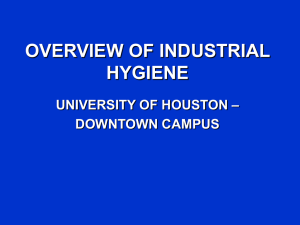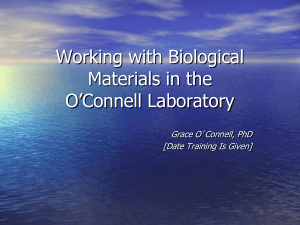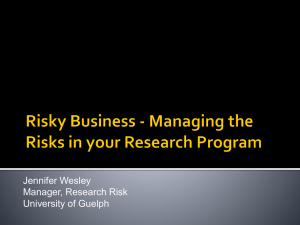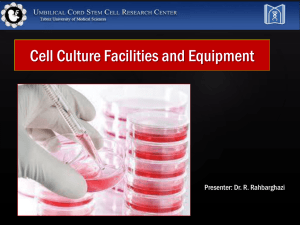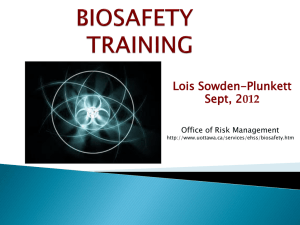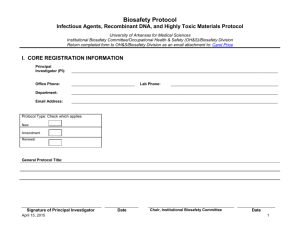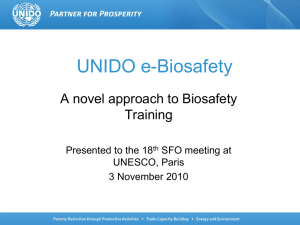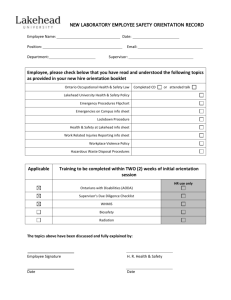Flow Cytometry and Biosafety - University of Colorado Denver
advertisement
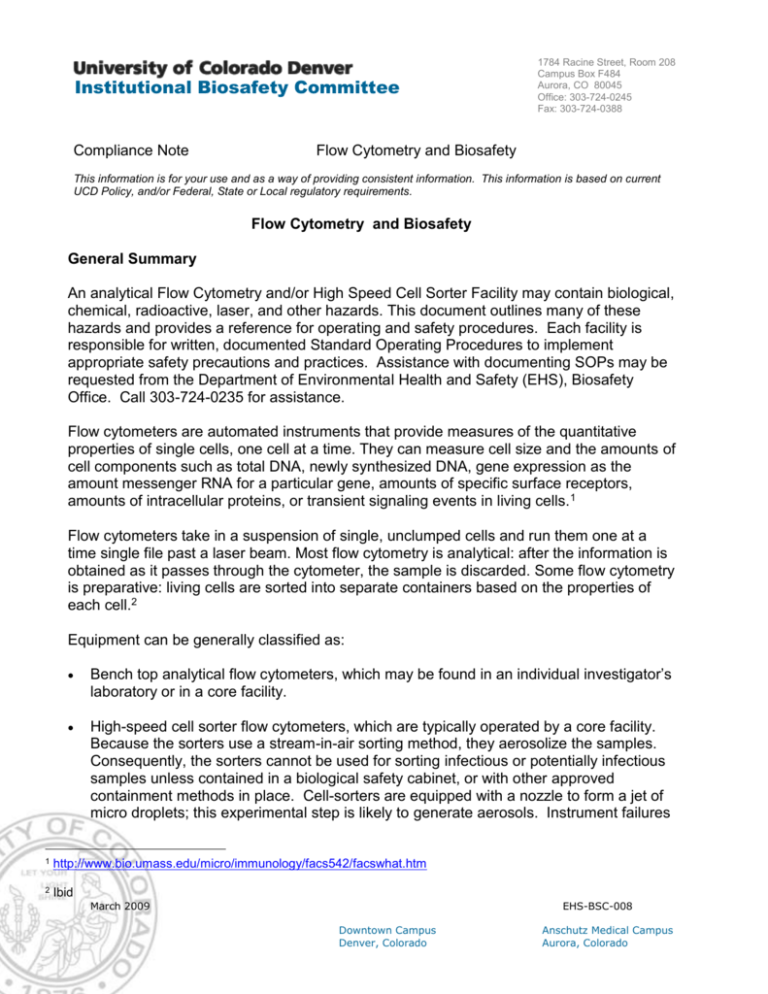
Institutional Biosafety Committee Compliance Note 1784 Racine Street, Room 208 Campus Box F484 Aurora, CO 80045 Office: 303-724-0245 Fax: 303-724-0388 Flow Cytometry and Biosafety This information is for your use and as a way of providing consistent information. This information is based on current UCD Policy, and/or Federal, State or Local regulatory requirements. Flow Cytometry and Biosafety General Summary An analytical Flow Cytometry and/or High Speed Cell Sorter Facility may contain biological, chemical, radioactive, laser, and other hazards. This document outlines many of these hazards and provides a reference for operating and safety procedures. Each facility is responsible for written, documented Standard Operating Procedures to implement appropriate safety precautions and practices. Assistance with documenting SOPs may be requested from the Department of Environmental Health and Safety (EHS), Biosafety Office. Call 303-724-0235 for assistance. Flow cytometers are automated instruments that provide measures of the quantitative properties of single cells, one cell at a time. They can measure cell size and the amounts of cell components such as total DNA, newly synthesized DNA, gene expression as the amount messenger RNA for a particular gene, amounts of specific surface receptors, amounts of intracellular proteins, or transient signaling events in living cells. 1 Flow cytometers take in a suspension of single, unclumped cells and run them one at a time single file past a laser beam. Most flow cytometry is analytical: after the information is obtained as it passes through the cytometer, the sample is discarded. Some flow cytometry is preparative: living cells are sorted into separate containers based on the properties of each cell.2 Equipment can be generally classified as: Bench top analytical flow cytometers, which may be found in an individual investigator’s laboratory or in a core facility. High-speed cell sorter flow cytometers, which are typically operated by a core facility. Because the sorters use a stream-in-air sorting method, they aerosolize the samples. Consequently, the sorters cannot be used for sorting infectious or potentially infectious samples unless contained in a biological safety cabinet, or with other approved containment methods in place. Cell-sorters are equipped with a nozzle to form a jet of micro droplets; this experimental step is likely to generate aerosols. Instrument failures 1 http://www.bio.umass.edu/micro/immunology/facs542/facswhat.htm 2 Ibid March 2009 EHS-BSC-008 Downtown Campus Denver, Colorado Anschutz Medical Campus Aurora, Colorado such as a clogged sort nozzle or air in the fluidic system can drastically increase aerosol formation. Biological exposures to infectious or potentially infectious materials may arise in flow cytometry core from sample handling or from aerosols and droplets generated by the use of an analyzer or high-speed cell sorter. Although most biosafety concerns are associated with working with unfixed or infectious materials, biological specimens can contain either know or unknown pathogens. Work with animal specimens that may contain infectious, zoonotic agents or animal pathogens, is also a concern. Transmission of known or unknown pathogens can occur through percutaneous or mucous membrane exposure or inhalation due to occupational exposures to droplets or aerosols. Additionally, many dyes used for staining in flow cytometry protocols are toxins, mutagens or carcinogens. Exposure risks increase when the operator accepts specimens, without being aware of all the details concerning the biological nature of the specimens. Biosafety considerations should be taken into account with all sample handling of specimens from human or animal patients; any recombinant nucleic acid materials (rDNA, rRNA, viral vectors, transgenes, etc). The laboratory must develop appropriate procedures to identify the potential biological hazards of the specimens and for aerosol containment, waste management and equipment maintenance. If a sample contains lentivirus, adenovirus, or any other genetically engineered amphotropic virus, it must be treated as a potentially infectious hazard and all Biosafety Level 2 practices and procedures must be followed.3 This means that any specimens must be kept closed at all times except when being put onto the cytometer sample introduction port. Vortexing of open tubes is always prohibited. Vortexing of any closed tube should be done in a biological safety cabinet, if available. Otherwise, personnel must take great care when vortexing and when opening vortexed materials. High speed sorting generates aerosols. Typically, only fixed materials may be sorted in a cell-sorter, not otherwise contained in a biological safety cabinet.4 Thus, you may not sort lentivirus or adenovirus or otherwise infected cells unless you can conclusively demonstrate that there is no free virus in the system. For lentivirus, this is generally true if there have been at least seven culture passages after infection. If you have used a viral vector to introduce potentially hazardous elements into the cells (e.g. oncogenes), they may not be sorted unless the cell-sorter is contained in a biological safety cabinet. 3 All laboratories at UCD-Anschutz Medical Campus are designed at Biosafety Level 2 containment, at a minimum, with uni-directional, inward airflow (negative pressure) ventilation. Limited access to BSL2 laboratories is achieved through a variety of security approaches, including but not limited to keyed locks, cipher locks, ID card-secured access, and where appropriate, other biometric measures. 4 The UCCC Flow Cytometry core does not have contained high-speed cell sorting equipment for sorting of live, potentially infectious materials as of this writing. Biological Hazards Sorting of Unfixed Cells All manipulations of unfixed human specimens must be conducted in accordance with the University policy on Bloodborne Pathogens/Exposure Control. Unfixed biological specimens of human or animal origin can harbor known and unknown pathogens that may be transmitted through droplets and aerosols that are generated during the cell sorting process. This requires handling all unfixed human specimens as potentially infected with HIV, Hepatitis B and/or Hepatitis C. This also requires the PI assure personnel are trained in the required procedures with strict adherence to the Standard Precautions described in the University policy, and the PI must provide Hepatitis B vaccinations. Each facility must implement the appropriate containment and personnel protective equipment and Standard Operating procedures to accept and sort unfixed cells from potentially infectious sources include but are not limited to: Unfixed human materials from patients (blood samples, various body fluids, cultured cells and environmental samples) shall be considered as potentially infectious, per the OSHA Bloodborne Pathogens Standard and University policy (e.g. peripheral blood leukocytes, bone marrow, etc.) Unfixed cells from primary or immortalized cultures from human donors or of human origins (e.g. HELA cells, tumor cells lines, etc) Unfixed cells from primary and immortalized cultures from animal donors, to include non-human, primates, other species, and transgenic animals. CD34 stem cells, fused dendritic cells + tumor cells, tumor cells which have been transfected with rDNA or synthetic nucleic acid molecules, It is incumbent upon the laboratory (Principal Investigator or other research staff) requesting the analysis or cell sorting analysis to thoroughly divulge any and all potentially infectious or biologically hazardous materials in any specimen submitted. Laser Hazards Lasers are used in many of these instruments. With few exceptions, these machines include hard-to-disable safety devices that prevent user exposure to the beams in normal use. Analytical flow cytometers only present a laser hazard if the safety covers are removed or the interlocks are defeated. Users are reminded not to stare at the objective/specimen while the instrument is scanning. Biosafety Requirements Facility Design and Operation For the purposes of working with any human materials and certain animal materials (to include tissues, primary and immortalized cell lines) those materials are defined as Risk Group 2 (RG2) materials for laboratory manipulations, which must be conducted with Biosafety Level 2 containment and practices. All research laboratories at UCD-Anschutz Medical Campus are designed with uni-directional, inward airflow (negative pressure) ventilation at a minimum of Biosafety Level 2 containment. Limited access to these BSL2 laboratories is achieved through a variety of security approaches, including but not limited to keyed locks, cipher locks, ID card-secured access, and where appropriate, other biometric measures. While egress is never limited, these facilities will, at a minimum, have the laboratory door closed at all times when materials are being analyzed or sorted, to prevent inadvertent entry, with appropriate signage posted as applicable. (See Appendix 2 for an example). BSL 2 containment also consists of the work practices (good microbiological laboratory technique) and when appropriate, a certified, properly operating biosafety cabinet (BSC), typically Class II, Type A, or Type A/B3. Work will be performed in a biosafety cabinet (BSC) as appropriate. University policies mirror the BMBL, including the specific items that hand-washing sinks are readily available to laboratory staff; food and drink are prohibited in the laboratories; and only mechanical pipetting devices are permitted. Work surfaces must be disinfected with an EPA-approved disinfectant appropriate to the materials manipulated in the laboratory as work is completed each day. Personal Protective Equipment Operators must wear appropriate PPE for the procedures and the materials to be analyzed or sorted. This includes at a minimum, gloves, lab coat or disposable Tyvek gown and eye protection. Work with certain materials may also require respiratory protection (in the form of N-95, N99 or N-100 respirators or PAPRs) in addition to the use of biological safety cabinets for containment. Additional information on respiratory protection devices, training and fit-testing is available through the EHS department. Call 303-724-0345 for assistance. Sample Identification and Handling A biosafety assessment of some type must be carried out by the facility to assure that the operator will have specific knowledge of the origin of the sample and awareness of the potential presence of pathogens or genetically modified material. This is critical to protection of the operator. A biosafety information sheet or questionnaire on the specimens will be completed and approved by the flow cytometry laboratory manager prior to the start of any new experiments. An example is provided as an appendix to this document, for implementation at each individual core or laboratory. The appropriate biosafety containment level must be applied in relation to the nature and status (e.g. live vs. fixed cells) of the sample. Guidelines on handling and proper disposal of biological materials must be followed in all flow cytometry laboratories. Aerosol Containment Infectious or potentially infectious materials should not be sorted unless suitable containment measures are applied. A droplet containment module should be installed to reduce the risk of exposure to generated droplets and aerosols. Only personnel trained in safety protocols should be permitted to run these flow cytometry analyzers and cell sorters. The efficiency of aerosol control measures on the instruments needs to be tested periodically. Sorters must be engineered with an aerosol evacuation system and this must be on and operational throughout the sort. Operators must have procedures in place to maintain and test the aerosol evacuation system. Records must be maintained to show the aerosol evacuation system is functioning normally. The efficiency of aerosol control measures on the instruments needs to be tested periodically. The UCD Biosafety Office recommends testing be conducted at least monthly and documented in writing. Observation of the flow scattering using calibrated fluorescent microspheres such as "Glo Germ"™ is a rapid and inexpensive method to provide good qualitative aerosol containment data. Preventive Maintenance and Equipment Validation Each facility with a flow cytometer analyzer or high-speed cell sorter shall incorporate routine Preventive Maintenance schemes in accordance with Operating Manuals provided by the manufacturer(s) and established practices. For all equipment with aerosol management hardware, routine aerosol containment testing must be documented in writing and those records maintained. The UCD Biosafety Office recommends not less than monthly testing be conducted and documented in writing. Any device with a HEPA-filtered aerosol management system must have that device inspected and certified at least annually. Waste Management Effluent shall be collected from the instrument into a container that contains fresh concentrated bleach or other suitable disinfectant, in sufficient quantity to achieve a 10% final concentration. Fluid lines shall be decontaminated routinely with freshly diluted (1% to 10%) bleach solution or other appropriate disinfectant solution. All waste is disposed according to institutional and local regulations for waste disposal. Training In accordance with the OSHA BBP Standard, the UCD Exposure Control and UCD Biosafety policies and with in compliance with the NIH Guidelines for Research Involving recombinant DNA, all personnel working with potentially infectious materials will participate in the campus training upon initial hire and on an annual basis thereafter for refresher training. On-line training is available to all University personnel who will be using Biological Safety Cabinets (BSCs) to assure they are familiar with the equipment and how to appropriately manipulate potentially infectious materials within those particular enclosures. On-line training is provided for all University personnel who may be involved in the packaging, documentation, shipping and receipt of biological materials, to comply with U. S. DOT and all air transport regulations. Principal Investigators are responsible for assuring the technical competence of their research staff, students and employees in their laboratories and documenting onthe-job training as appropriate, for the materials in use in each laboratory. Occupational Health The University has an Occupational Health and Medical Surveillance program under the auspices of the Department of Environmental Health and Safety. All personnel with animal contact in research will enroll in the Occupational Health and Medical Surveillance program. All employees are offered Hepatitis B vaccine when there is potential exposure to bloodborne pathogens, human blood, bodily fluids and tissues. Other immunizations will be offered as appropriate for work with other vaccinepreventable disease agents, and other occupational health screening is provided as appropriate to the materials and potential exposures associated with the laboratoryspecific research. The University Risk Management office provides comprehensive Workers Compensation programs for all University employees in the event of incident, accidents, spills, potential exposures or actual exposures to infectious agents or recombinant DNA. All such incidents will be immediately reported to the laboratory manager, supervisor or Principal Investigator, the Biosafety Office of EHS and the Workers Compensation program, as applicable. Appendix 1 Flow Cytometry Cell Sorting Questionnaire/Form Sample Laboratory Director (Principal Investigator) Phone Number E-mail Investigator (Experimenter) Phone Number E-mail Project Title: Biosafety Authorization Number Project start date/end date 1. Summary of project:(Provide details of cells to be sorted) 2. Will the sample be fixed before submitting to the laboratory? o Yes o No If yes, describe the fixation protocol, fixative and concentration, and exposure time. 3. List type of sample and source. a) Circle one of the following as applicable: Clinical sample (human) Cultured cells cell lines or other (ATCC # if applicable) If it is a clinical sample, has it been screened for bloodborne pathogens? o Yes o No If yes, for which pathogens? ___________________________________________ Could the sample contain other known human pathogens? o Yes o No b) For cultured eukaryotic cell specimens, identify source (circle one) Human Non-human primate Rodent Other:___________________ (specify) Have the cells been tested for mycoplasma and/or viral infection? o Yes o No Were the cells transformed using any virus such as SV-40, EBV, CMV, HTLV-1, or Herpes saimiri? o Yes o No If yes, describe method for determining that no live virus remains in the culture.5 5 Example: There have been at least 7 culture passages after infection in our laboratory. c) For prokaryote specimens, identify source (circle one) Bacteria Fungi Parasite Description (strain, species, subtype, etc): (with ATCC # if applicable) 4. Does the sample contain any other known human or animal infectious agent(s), viral vectors or recombinant DNA materials? o Yes o No If yes, list agents or materials. Has the infectious agent been inactivated or rendered non-infectious? o Yes o No If yes, describe method of inactivation. 5. Does the material express any known oncogenes? If yes, provide details. o Yes o No 6. Were the cells otherwise genetically engineered or altered? o Yes o No If yes, describe how they were otherwise genetically engineered or altered. 7. Was a viral vector (adenovirus, retrovirus, lentivirus, herpes virus, etc.) used to transfer genetic information to the cells? o Yes o No If yes, describe method for determining that no live virus remains in the culture.6 If yes, describe method in detail, attach vector map and show packaging cell line. I have read and answered the above questions carefully and certify the information provided to be correct. Signature (Principal Investigator) Date: Example: There have been at least 7 culture passages after infection in our laboratory. Or “We have tested for Replication Competent Lentivirus (with description of testing methods and results).” 6 Appendix 2 Flow Cytometry-Cell Sorter Lab Signage Authorized Personnel ONLY BIOSAFETY LEVEL 2 PROCEDURES IN PROCESS Contacts Laboratory Director: Laboratory Manager:
